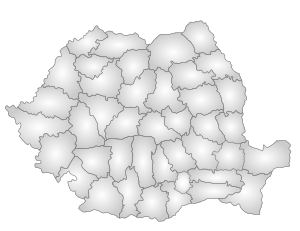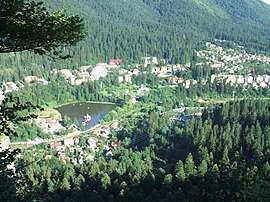Harghita County
Harghita (Romanian pronunciation: [harˈɡita] (![]()
Harghita County Județul Harghita Hargita megye | |
|---|---|
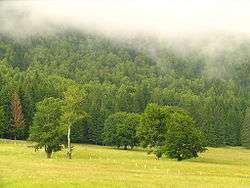 Landscape around Lake Sfânta Ana, southern Harghita County | |
 Coat of arms | |
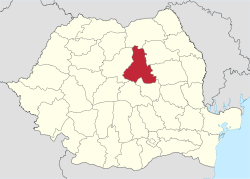 Harghita county, territorial location | |
| Country | |
| Development region1 | Centru |
| Historic region | Transylvania |
| Capital city (Reședință de județ) | Miercurea Ciuc |
| Government | |
| • Type | County Board |
| • President of the County Board | Csaba Borboly (UDMR) |
| • Prefect2 | Ion Proca |
| Area | |
| • Total | 6,639 km2 (2,563 sq mi) |
| Area rank | 13th in Romania |
| Population (2011) | |
| • Total | 304,969 |
| • Rank | 33rd in Romania |
| • Density | 46/km2 (120/sq mi) |
| Time zone | UTC+2 (EET) |
| • Summer (DST) | UTC+3 (EEST) |
| Postal Code | 53wxyz3 |
| Area code(s) | +40 x664 |
| Car Plates | HR5 |
| GDP | US$1.840 billion (2015) |
| GDP/capita | US$6,033 (2015) |
| Website | County Board County Prefecture |
| 1The developing regions of Romania have no administrative role. They were formed just to attract funds from the European Union 2 as of 2007, the Prefect is not a politician, but a public functionary. He (or she) is not allowed to be a member of a political party, and is banned from having any political activity in the first six months after the resignation (or exclusion) from the public functionary corps 3w, x, y, and z are digits that indicate the city, the street, part of the street, or even the building of the address 4x is a digit indicating the operator: 2 for the former national operator, Romtelecom, and 3 for the other ground telephone networks 5used on both the plates of the vehicles that operate only in the county limits (like utility vehicles, ATVs, etc.), and the ones used outside the county | |
Demographics
2002 census
In 2002, Harghita County had a population of 326,222[1] and a population density of 52/km2.
2011 census
In 2011, it had a population of 302,432[3] and a population density of 46/km2.
- Hungarians – 85.21% (or 257,707)[4]
- Romanians – 12.96% (or 39,196)
- Romani, others – 1.76% (or 5,326).
Harghita county has the highest percentage of Hungarians in Romania, just ahead of Covasna county. The Hungarians form the majority of the population in most of the county's municipalities, with Romanians concentrated in the northern and eastern part of the county (particularly Toplița and Bălan), as well as in the enclave of Voșlăbeni.
The Székelys of Harghita are mostly Roman Catholic, with Reformed and Unitarian minorities, while the ethnic Romanians are primarily Orthodox. Catholicism is strongest in the east, in the former Csíkszék, while Protestants are concentrated in the west, south and west of Odorheiu Secuiesc. By religion, the county is divided roughly as follows:
- Roman Catholic (65%)
- Orthodox (13%)
- Reformed (13%)
- Unitarian (7%)
- Other (2%)
Demographic evolution

Geography
Harghita County has a total area of 6,639 km2.
Harghita consists primarily of mountains, connected to the Eastern Carpathians, such as the Ciuc and Harghita Mountains; volcanic plateaux, foothills, and the more densely populated river valleys.
The mountains are volcanic in origin, and the region is known for its excellent hot mineral springs. Harghita is known as one of the coldest regions in Romania, although summers can be quite warm.
It is in this county that two of the most important rivers in Romania, the Mureș and the Olt, originate. These rivers' origins, near the villages of Izvoru Mureșului and Sândominic, are only a few miles apart; yet the Mureș flows west to the Tisza, while the Olt flows south to the Danube. In the western part of the county the two Târnava rivers (Târnava Mare and Târnava Mică) flow to the Târnava Plateau, which is part of the Transylvanian Plateau.
Harghita's spectacular natural scenery includes Sfânta Ana Lake, a volcanic crater lake near the town of Băile Tușnad; Lacul Roșu a mountain lake in the northeast near the town of Gheorgheni, and Cheile Bicazului, a dramatic, narrow canyon formed by the Bicaz stream. The county is renowned for its spa resorts and mineral waters.
Economy
The county's main industries:
- Wood industry – up to 30%;
- Foods and beverages industry;
- Textile and leather processing;
- Mechanical components.
Tourism
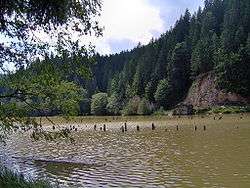
The main tourist attractions in Harghita county are
- The cities of Miercurea Ciuc, Odorheiu Secuiesc, Gheorgheni, Toplița.
- The mountain resorts of
- Băile Tușnad
- Borsec
- Lacul Roșu
- Izvorul Mureşului
- Harghita Băi
- Lake Sfânta Ana (crater lake)
Politics
The Harghita County Council, elected at the 2016 local government elections, is made up of 31 counselors, with the following party composition:[5]
| Party | Seats | Current Council | |||||||||||||||||||
|---|---|---|---|---|---|---|---|---|---|---|---|---|---|---|---|---|---|---|---|---|---|
| Democratic Union of Hungarians in Romania | 19 | ||||||||||||||||||||
| Hungarian Civic Party | 4 | ||||||||||||||||||||
| Hungarian People's Party of Transylvania | 3 | ||||||||||||||||||||
| Social Democratic Party | 3 | ||||||||||||||||||||
| National Liberal Party | 2 | ||||||||||||||||||||
Administrative divisions
Harghita County has 4 municipalities, 5 towns and 58 communes
- Municipalities
- Gheorgheni
- Miercurea Ciuc – county seat; population: 37,980 (as of 2011)
- Odorheiu Secuiesc
- Toplița
- Towns
|
|
|
|
See also
- Former Csík County of the Kingdom of Hungary
References
| Wikimedia Commons has media related to Harghita County. |
- National Institute of Statistics, "Populația la recensămintele din anii 1948, 1956, 1966, 1977, 1992 și 2002" Archived 22 September 2006 at the Wayback Machine
- National Institute of Statistics, "Populația după etnie" Archived 16 August 2009 at the Wayback Machine ("Population by ethnicity")
- National Institute of Statistics,
- Recensamantul Populatiei si Locuintelor 2011: Populația stabilă după etnie – județe, municipii, orașe, comune
- "Mandate de CJ pe judete si competitori" (in Romanian). Biroul Electoral Central. 10 June 2016. Retrieved 16 June 2016.
